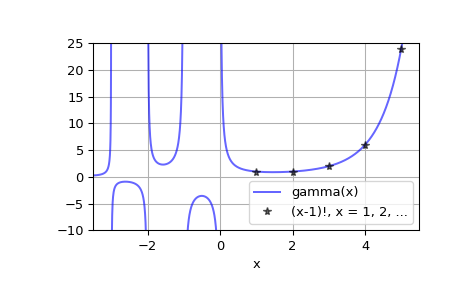scipy.special.gamma#
- scipy.special.gamma(z, out=None) = <ufunc 'gamma'>#
gamma function.
The gamma function is defined as
\[\Gamma(z) = \int_0^\infty t^{z-1} e^{-t} dt\]for \(\Re(z) > 0\) and is extended to the rest of the complex plane by analytic continuation. See [dlmf] for more details.
- Parameters
- zarray_like
Real or complex valued argument
- outndarray, optional
Optional output array for the function values
- Returns
- scalar or ndarray
Values of the gamma function
Notes
The gamma function is often referred to as the generalized factorial since \(\Gamma(n + 1) = n!\) for natural numbers \(n\). More generally it satisfies the recurrence relation \(\Gamma(z + 1) = z \cdot \Gamma(z)\) for complex \(z\), which, combined with the fact that \(\Gamma(1) = 1\), implies the above identity for \(z = n\).
References
- dlmf
NIST Digital Library of Mathematical Functions https://dlmf.nist.gov/5.2#E1
Examples
>>> from scipy.special import gamma, factorial
>>> gamma([0, 0.5, 1, 5]) array([ inf, 1.77245385, 1. , 24. ])
>>> z = 2.5 + 1j >>> gamma(z) (0.77476210455108352+0.70763120437959293j) >>> gamma(z+1), z*gamma(z) # Recurrence property ((1.2292740569981171+2.5438401155000685j), (1.2292740569981158+2.5438401155000658j))
>>> gamma(0.5)**2 # gamma(0.5) = sqrt(pi) 3.1415926535897927
Plot gamma(x) for real x
>>> x = np.linspace(-3.5, 5.5, 2251) >>> y = gamma(x)
>>> import matplotlib.pyplot as plt >>> plt.plot(x, y, 'b', alpha=0.6, label='gamma(x)') >>> k = np.arange(1, 7) >>> plt.plot(k, factorial(k-1), 'k*', alpha=0.6, ... label='(x-1)!, x = 1, 2, ...') >>> plt.xlim(-3.5, 5.5) >>> plt.ylim(-10, 25) >>> plt.grid() >>> plt.xlabel('x') >>> plt.legend(loc='lower right') >>> plt.show()
